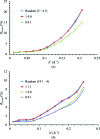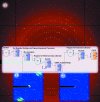The use of workflows in the design and implementation of complex experiments in macromolecular crystallography
- PMID: 22868763
- PMCID: PMC3413211
- DOI: 10.1107/S090744491201863X
The use of workflows in the design and implementation of complex experiments in macromolecular crystallography
Abstract
The automation of beam delivery, sample handling and data analysis, together with increasing photon flux, diminishing focal spot size and the appearance of fast-readout detectors on synchrotron beamlines, have changed the way that many macromolecular crystallography experiments are planned and executed. Screening for the best diffracting crystal, or even the best diffracting part of a selected crystal, has been enabled by the development of microfocus beams, precise goniometers and fast-readout detectors that all require rapid feedback from the initial processing of images in order to be effective. All of these advances require the coupling of data feedback to the experimental control system and depend on immediate online data-analysis results during the experiment. To facilitate this, a Data Analysis WorkBench (DAWB) for the flexible creation of complex automated protocols has been developed. Here, example workflows designed and implemented using DAWB are presented for enhanced multi-step crystal characterizations, experiments involving crystal reorientation with kappa goniometers, crystal-burning experiments for empirically determining the radiation sensitivity of a crystal system and the application of mesh scans to find the best location of a crystal to obtain the highest diffraction quality. Beamline users interact with the prepared workflows through a specific brick within the beamline-control GUI MXCuBE.
Figures








Similar articles
-
AutoDrug: fully automated macromolecular crystallography workflows for fragment-based drug discovery.Acta Crystallogr D Biol Crystallogr. 2013 May;69(Pt 5):796-803. doi: 10.1107/S0907444913001984. Epub 2013 Apr 11. Acta Crystallogr D Biol Crystallogr. 2013. PMID: 23633588 Free PMC article.
-
MxCuBE: a synchrotron beamline control environment customized for macromolecular crystallography experiments.J Synchrotron Radiat. 2010 Sep;17(5):700-7. doi: 10.1107/S0909049510020005. Epub 2010 Jul 13. J Synchrotron Radiat. 2010. PMID: 20724792 Free PMC article.
-
BL-11C Micro-MX: a high-flux microfocus macromolecular-crystallography beamline for micrometre-sized protein crystals at Pohang Light Source II.J Synchrotron Radiat. 2021 Jul 1;28(Pt 4):1210-1215. doi: 10.1107/S1600577521004355. Epub 2021 Jun 1. J Synchrotron Radiat. 2021. PMID: 34212886 Free PMC article.
-
Serial synchrotron crystallography for time-resolved structural biology.Curr Opin Struct Biol. 2020 Dec;65:168-174. doi: 10.1016/j.sbi.2020.06.019. Epub 2020 Aug 23. Curr Opin Struct Biol. 2020. PMID: 32846363 Review.
-
Application of in situ diffraction in high-throughput structure determination platforms.Methods Mol Biol. 2015;1261:233-53. doi: 10.1007/978-1-4939-2230-7_13. Methods Mol Biol. 2015. PMID: 25502203 Review.
Cited by
-
AutoDrug: fully automated macromolecular crystallography workflows for fragment-based drug discovery.Acta Crystallogr D Biol Crystallogr. 2013 May;69(Pt 5):796-803. doi: 10.1107/S0907444913001984. Epub 2013 Apr 11. Acta Crystallogr D Biol Crystallogr. 2013. PMID: 23633588 Free PMC article.
-
Measurement of the intrinsic variability within protein crystals: implications for sample-evaluation and data-collection strategies.Acta Crystallogr F Struct Biol Commun. 2014 Jan;70(Pt 1):127-32. doi: 10.1107/S2053230X13032007. Epub 2013 Dec 24. Acta Crystallogr F Struct Biol Commun. 2014. PMID: 24419635 Free PMC article.
-
ID30B - a versatile beamline for macromolecular crystallography experiments at the ESRF.J Synchrotron Radiat. 2018 Jul 1;25(Pt 4):1249-1260. doi: 10.1107/S1600577518007166. Epub 2018 Jun 27. J Synchrotron Radiat. 2018. PMID: 29979188 Free PMC article.
-
Fully automatic characterization and data collection from crystals of biological macromolecules.Acta Crystallogr D Biol Crystallogr. 2015 Aug;71(Pt 8):1757-67. doi: 10.1107/S1399004715011918. Epub 2015 Jul 31. Acta Crystallogr D Biol Crystallogr. 2015. PMID: 26249356 Free PMC article.
-
MXCuBE2: the dawn of MXCuBE Collaboration.J Synchrotron Radiat. 2019 Mar 1;26(Pt 2):393-405. doi: 10.1107/S1600577519001267. Epub 2019 Feb 22. J Synchrotron Radiat. 2019. PMID: 30855248 Free PMC article.
References
-
- Abeillé, G., Ounsy, M. & Buteau, A. (2007). Proceedings of ICALEPCS07, Knoxville, Tennessee, USA, pp. 647–649. http://accelconf.web.cern.ch/AccelConf/ica07/PAPERS/RPPB20.PDF.
-
- Adams, P. D. et al. (2010). Acta Cryst. D66, 213–221. - PubMed
-
- Beteva, A. et al. (2006). Acta Cryst. D62, 1162–1169. - PubMed
Publication types
MeSH terms
Substances
LinkOut - more resources
Full Text Sources

